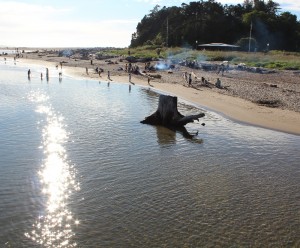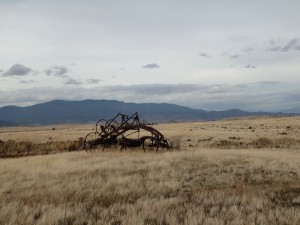Recently I happened across this excellent interview Minnesota Public Radio did with Richard Louv. Louv is the author of two key books in the modern environmental and ecopsychological fields, Last Child in the Woods and The Nature Principle. During the interview, Louv spent a good deal of time reframing the environmental movement in more constructive, positive ways. He pointed out that the prevailing “story” of environmentalism has largely been one of doom and gloom and “you’re all doing bad things!” This has led to a lot of people, especially younger people who are coming into their own in this world, to be unable to imagine the situation getting any better.
And who can blame them? It seems every day we’re assaulted by news stories of another oil spill, or the rate of deforestation in the Amazon, or the rise of cancer in heavily industrial areas. These are important things, but after a while even the most staunch activists can become desensitized to all the bad news. There are ecopsychologists who spend a great deal of time helping clients come to terms with their grief about the loss of wild places, and helping activists get through burnout in their work. More studies show how detachment from the non-human world negatively affects the human psyche. It should say a great deal that the environmental situation is so incredibly draining that we as individuals and as a community are suffering. But how much of that is our attitudes?

This calls for a more active use of our imaginations. How many of us temporarily escape the problems of our lives through a bit of daydreaming? This is a good practice, provided it isn’t done to excess. Giving our brains a break allows us to come back to our problems more fully and well-rested. And we can do the same with environmental problems by taking time off to just focus on what a green future could look like.
Some of us are pretty good with our imaginations; if you’d like a bit more framework to work with, here’s a guided meditation to try:
Find a comfortable, quiet place where you can be undisturbed for a while, at least half an hour if possible. Sit or lay down as you see fit, and focus on your breathing for a few minutes, letting it slow gradually as you relax. Let your thoughts clear out of your mind like mist clearing in the sunlight. Let go of everyday cares and let yourself be in the now.
Imagine what it would be like if you opened your eyes, and your society is one in which nature is a central concern, where sustainability is a top priority. What would you open your eyes to?
Imagine walking around your home. What would it look like? What is your home made of, and how is it shaped? Where did your furnishings and other belongings come from?
Go into the kitchen. Where does the light come from? What food is there, and where did it come from?
Head into your bedroom. Where did the clothing and bedding come from? How does the room stay warm or cool?
Now go outside. Where is your home located? Who else is around, and how close are your neighbors? What does the environment around you look like?
Imagine that you can walk as far as you want around here without getting tired, and that you can cover miles in a single step if you so choose. Go exploring. Where does your water come from? What about your power for lighting and heating/cooling? How far did you have to go to get food?

When you have explored enough for now, start to focus on your physical body again. Focus on your breathing again, the rise and fall of your chest and the filling of your lungs. With each breath, let your awareness of your body expand outward from there. Wiggle your fingers and toes, stretch your back, but keep your eyes closed until you’re ready to get up again.
Write down everything you remember, or if you like, draw or paint a picture of it. Hang onto it, and let it be an image of what you’re working toward in your green efforts. You may also use this meditation again whenever you feel the need for a bit of a boost. You can even keep records of each time through to see how your vision develops.
Don’t let this exercise be a discouragement, though. It can be easy to feel discontent because the world isn’t like your vision right now. Instead of thinking about what’s wrong, think about what’s going right. Think about what you are able to do as an individual and as a member of your community, and what others have accomplished. Think about the successes that have occurred, and, more importantly, connect them to your vision. And if you’re having trouble with finding examples of successes, here are a few suggestions:
Wolves in Chernobyl Dead Zone – nice documentary on how wolves and other wildlife have bounced back from the Chernobyl nuclear meltdown.
The Fight for Amazonia – another documentary, this one on concrete things people are doing to protect and preserve the Amazon rain forest.
Meeting India’s tree-planting guru – news article, “An Indian civil servant, SM Raju, has come up with a novel way of providing employment to millions of poor in the eastern state of Bihar.”
110 Success Stories for Endangered Species Day 2012 – concrete evidence of how the Endangered Species Act is helping the animals under its protection
Cost of solar decreasing – while the energy crisis is a tangled web, and China as a nation is no stranger to pollution and overpopulation issues, having solar energy be more accessible across the board can help reduce or even eliminate dependency on fossil fuels.
Five pieces of good news from Mother Earth – primarily good stories about animal species











